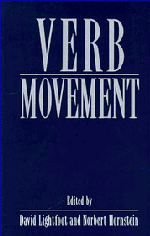Book contents
- Frontmatter
- Contents
- List of contributors
- Preface
- Verb movement: an introduction
- 1 Verb positions: evidence from Italian
- 2 Verb movement and word order in Arabic
- 3 Comments on the paper by Ouhalla
- 4 Some similarities and differences between Icelandic and Yiddish
- 5 Comments on the paper by Santorini
- 6 Finite verb movement in Scandinavian embedded clauses
- 7 Comments on the paper by Vikner
- 8 The Brythonic copula and head raising
- 9 A reinterpretation of evidence for verb movement in French
- 10 Two types of head movement in Romance
- 11 Comments on the paper by Roberts
- 12 Licensing heads
- 13 Comments on the paper by Koopman
- 14 Finiteness and head movement in early child grammars
- 15 Comments on the paper by Wexler
- References
- Index
13 - Comments on the paper by Koopman
Published online by Cambridge University Press: 03 May 2011
- Frontmatter
- Contents
- List of contributors
- Preface
- Verb movement: an introduction
- 1 Verb positions: evidence from Italian
- 2 Verb movement and word order in Arabic
- 3 Comments on the paper by Ouhalla
- 4 Some similarities and differences between Icelandic and Yiddish
- 5 Comments on the paper by Santorini
- 6 Finite verb movement in Scandinavian embedded clauses
- 7 Comments on the paper by Vikner
- 8 The Brythonic copula and head raising
- 9 A reinterpretation of evidence for verb movement in French
- 10 Two types of head movement in Romance
- 11 Comments on the paper by Roberts
- 12 Licensing heads
- 13 Comments on the paper by Koopman
- 14 Finiteness and head movement in early child grammars
- 15 Comments on the paper by Wexler
- References
- Index
Summary
Koopman offers a concrete implementation of some ideas which are independently introduced in Uriagereka (1988). Her proposal has interesting consequences for binary branching, the Projection Principle, X'-shells, and the Uniformity Condition, and it offers a motivation for head movement. Since some of these results are still tentative, the assumptions behind them relying on work in progress, I will not comment on them. I want to concentrate on the notion of “licensing heads.” In particular, I want to discuss whether it is a head licensing another head that determines the properties of incorporation, whether it is the licensed head that does, or whether both licenser and licensee may be relevant.
Uriagereka (1988) arrived at the conclusion that incorporation is a universal process that serves to implement argument substitution. That work explored government relations and the process of cliticization in Romance. Following Kayne (1987) and Torrego (1988), it analyzed clitic placement as D(eterminer)-incorporation, for which independent evidence was presented in the process of generalized D-incorporation from standard DP complements in archaic Romance.
In the light of languages that say vimo-lo home ‘we saw-the man’ (Galician), the reason why the determiner in these languages attaches to the verb was explored. Having shown that the process is not phonological, I concluded that incorporation is involved. The proposal is that D-incorporation is universal at LF, and we see it overtly in some languages. The determiner (which takes a set of phi features and, as such, arguably a referential index) is analyzed as representing a variable that substitutes for a thematic slot in the theta-grid of the verb.
- Type
- Chapter
- Information
- Verb Movement , pp. 297 - 304Publisher: Cambridge University PressPrint publication year: 1994



